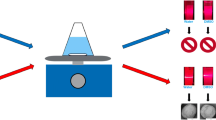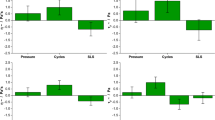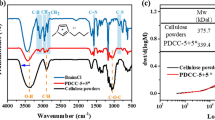Abstract
The study objective was to investigate the influence of the degree of polymerization (DP) of cellulose materials (microcrystalline cellulose [MCC] and powder cellulose [PC]) on the behavior of these materials during homogenization and extrusion/spheronization processes. Suspensions of the cellulose types with different DP values were homogenized using a high-pressure homogenizer. The particle size, agglomeration index, and apparent viscosity of these suspensions was determined at different times after pouring. Additionally, these different cellulose types were processed into pellets using the extrusion/spheronization, method, and the water content and power consumption as a function of the DP were determined. Cellulose types with a high DP value showed greater particle size after homogenization, than the types with a low DP value. In contrast, no relevant relationship between the apparent viscosity and DP could be observed. During the extrusion process, water content in the extrudate and pellet porosity were increased as the DP was increased for the extrudates produced at the same level of power consumption. MCC types with various DPs compared with PC provided a novel way of understanding the role of cellulose in the extrusion process. The DP showed a remarkable influence on the physicochemical properties of the cellulose materials and, consequently, on the behavior of these materials during the extrusion/spheronization process. It is postulated that the sponge model is more appropriate for the cellulose type with high DP (PC), whereas the gel model is more applicable to cellulose types with lower DP (MCC).
Similar content being viewed by others
References
Kleinebudde P, Sølvberg AJ, Lindner H. The powerconsumption-controlled extruder-;a tool for pellet production. J Pharm Pharmacol. 1994;46:542–546.
Kleinebudde P. Use of a power-consumption-controlled extruder in the development of pellet formulations. J Pharm Sci. 1995;84:1259–1264.
Fielden KE, Newton JM. Extrusion and extruders. In: Swarbrick J, Boylan JC, Eds. Encyclopedia of Pharmaceutical Technology, Vol. 5. New York, Basel: Marcel Dekker, 1992.
Lindner H, Kleinebudde P. Use of powdered cellulose for the production of pellets by extrusion/spheronization. J Pharm Pharmacol. 1994;46:2–7.
Bataille B, Amourdedieu A, Sonaglio D, et al. Preformulation in extrusion-spheronization: behavioural study of two microcel cellulose grades. Pharmazie. 1997;52:138–144.
Miyake Y, Shinoda A, Uesugi K, Furukawa M, Nasu T. The influence of amount of water on granulation efficiency and physical properties of spherical granules prepared by extrusion-spheronization processing. Yakuzaigaku. 1973;33:167–171.
Iyer RM, Augsburger LL, Pope DG, Shah RD. Extrusion/spheronization-;effect of moisture content and spheronization time on pellet characteristics. Pharm Dev Technol. 1996;1: 325–331.
Schmidt C, Kleinebudde P. Significance of the granulation step in pelletization by extrusion/spheronization. Chem Pharm Bull. 1999;47:405–412.
Vervaet C, Baert L, Remon JP. Extrusion-spheronisation. A literature review. Int J Pharm. 1995;116:131–146.
Fielden KE, Newton JM, Rowe RC. The influence of moisture content on spheronization of extrudate processed by a ram extruder. Int J Pharm. 1993;97:79–92.
Tomer G, Newton JM. Water movement evaluation during extrusion of wet powder masses by collecting extrudate fractions. Int J Pharm. 1999;182:71–77.
Ek R, Newton MJ. Microcrystalline cellulose as a sponge as an alternative concept to the crystalline-gel model for extrusion and spheronization. Pharm Res. 1998;15:509–510.
Kleinebudde P. The crystallite-gel-model for microcrystalline cellulose in wet-granulation, extrusion, and spheronization. Pharm Res. 1997;14:804–809.
Newton JM, Chow AK, Jeewa KB. The effect of excipient source on spherical granules made by extrusion/spheronization. Pharm Tech Int. 1992;4 October:52–58.
Law ML, Deasy PB, McLaughlin JP, Gabriel SG. Comparison of two commercial brands of microcrystalline cellulose for extrusion-spheronization. J Microencapsulation. 1997;14:713–723
Jumaa M, El Saleh F, Hassan I, Müller BW, Kleinebudde P. Influence of cellulose type on the properties of extruded pellets. Part I: Physicochemical characterisation of the cellulose types after homogenization. Colloid Polym Sci. 2000;278:597–607.
El Saleh F, Jumaa M, Hassan I, Kleinebudde P. Influence of cellulose type on the properties of extruded pellets. Part II: Production and properties of pellets. STP Pharma Science. In press.
Rowe RC, McKillop AG, Bray D. The effect of batch and source variation on the crystallinity of microcrystalline cellulose. Int J Pharm. 1994;101:169–172.
Knolle H, Jayme G. Über ein digitales Verfahren zur empirischen Bestimmung der Röntgenkristallinität cellulosehaltiger Stoffe und seine Anwendung. Das Papier. 1965;19:106–110.
Microcrystalline cellulose. In: European Pharmacopoeia. 3rd ed. Stuttgart: Deutscher Apotheker Verlag; 1997;665–666.
Dong XM, Revol JF, Gray DG. Effect of microcrystallite preparation conditions on the formation of colloid crystals of cellulose. Cellulose. 1998;5:91–32.
Bleich JU, Kleinebudde P, Müller BW. Influence of gas density and pressure on microparticles produced with the ASES process. Int J Pharm. 1994;106:77–84.
Thies J, Müller BW. Size controlled production of biodegradable microparticles with supercritical gases. Eur J Pharm Biopharm. 1998;45:66–74.
Lindner H, Kleinebudde P. Application of automatic image analysis for the characterization of pellets (German). Pharm Ind. 1993;55:694–701.
Ek R, Alderborn G, Nystroem C. Particle analysis of microcrystalline cellulose: differentiation between individual particles and their agglomerates. Int J Pharm. 1994;111:43–50.
Kleinebudde P. Shrinking and swelling of pellets containing microcrystalline cellulose (MCC) and low substituted hydroxypropylcellulose (L-HPC). Part I: Shrinking properties. Int J Pharm. 1994;109:209–219.
Suzuki T, Nakagami H. Effect of crystallinity of microcrystalline cellulose on the compactability and dissolution of tablets. Eur J Pharm Biopharm. 1999;47;225–230.
Ono H, Yamada H, Matsuda S, Okajima K, Kawamoto T, Iijima H: 1H-NMR relaxation of water molecules in the aqueous microcrystalline cellulose suspension systems and their viscosity. Cellulose. 1998;5:231–247.
Author information
Authors and Affiliations
Additional information
published July 21, 2000
Rights and permissions
About this article
Cite this article
Kleinebudde, P., Jumaa, M. & El Saleh, F. Influence of degree of polymerization on behavior of cellulose during homogenization and extrusion/spheronization. AAPS PharmSci 2, 23 (2000). https://doi.org/10.1208/ps020321
Received:
Accepted:
Published:
DOI: https://doi.org/10.1208/ps020321




